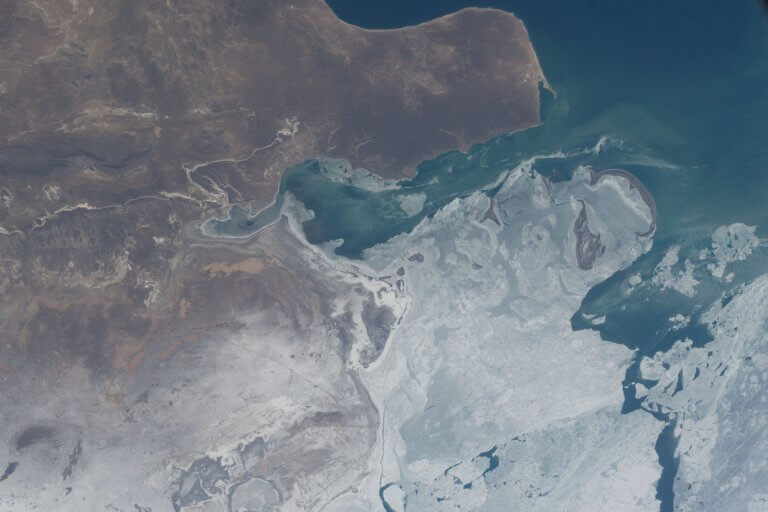
Buzachi Peninsula Deserts
If you’re interested in obscure, remotely situated deserts, the Buzachi Peninsula has five small, sandy ones*: the Kyzylkum, Uvahkum, Shulshagylkum, Zhilimshik and Egizlak. The Kyzylkum
Fifty-five kilometres south-east of Aktau city is the Karagiye Depression. At –132m below sea level, it’s the lowest point in Central Asia and the former Soviet Union.
Size estimates vary, but it’s over 20km wide and at least 40km in length. Its deepest point is the Batyr salt flat, in the southern half. The name ‘Karagiye’ derives from the Turkic words kara (black) and kiya (steep slope).
Its southernmost point is several kilometres east of Eralievo town, which has a train station, and is near the E-121 and R-114 roads leading to Kuryk Port. The northernmost point peters out near the A-33 road, which connects Aktau and Zhanaozen city.
Despite the rugged and hostile-looking landscape, it’s home to a wide variety of animals, such as caracal, Pallas’ cat (aka manul), corsac and steppe fox, and mouflon. There’s also plenty of monitor lizards, tortoise, snakes, centipedes, and scorpions living around the depression’s cliffs and ravines. Its rich biodiversity also makes it a popular spot for hawks and vultures.
Together with Lake Karakol, 30km+ to the west, the depression is part of the 130,000+ hectare Karagiye-Karakol Nature Reserve. The reserve area also has some human activity, with oil derricks, camel farms, and watermelon and tomato plantations dotted around parts of the desert.
Less than 15km west of Karagiye is the 15-kilometre-wide, bowl-shaped Ashchisor Depression*, which is inland of Cape Peschaniy and Cape Sarzha. Since 2018, there are discussions of developing a hotel and recreational area in Ashchisor and turning part of it into a reservoir for leisure use. The plan involves cutting a channel, at a cost of US$130+ million, from the Caspian Sea to the depression to flood the area. For now, the project appears to be on hold as the local government and environmental groups assess how to minimise the development’s environmental impact.
Less than 5km north of Cape Peschaniy, meaning ‘sandy’ in Russian, is a lighthouse. With an off-road vehicle, it should in theory be possible to drive most of the 100-kilometre length of coastline between Aktau and Kuryk Port. The lighthouse is on the route, along with extensive stretches of sandy beach and a hot spring that’s popular with Mangystau’s residents.
* The ‘ashchi’ prefix derives from the Kazakh word for ‘bitter’.
To visit the Karagiye Depression, take the A-33 road out of Aktau, toward Zhanaozen and Zhetybay. Drive 30km along the road, for approximately 40 minutes, to reach a series of southerly dirt roads leading near to the bottom of Karagiye. Another 12km further east of the turn-off is a popular viewpoint overlooking the depression’s north side. If you’re headed to the bottom of Karagiye or driving on any dirt roads surrounding its perimeter, it’s strongly recommended going with a 4WD.
Eralievo Town (Ералиево): 43.2191, 51.8172
Kuryk Town (Qūryq/Курык): 43.1797, 51.6780
Zhetybay Town (Jetıbai/Жетыбай): 43.5900, 52.0990
Karagiye Depression viewpoint (Qaraqiia Oiysy/Смотровая площадка Впадина Каракия): 43.5604, 51.7922
Dirt Roads to the Bottom of Karagiye Depression: 43.5890, 51.6329
Ashchisor Depression (Aşchisor Oiysy/Впадина Ащисор): 43.2631, 51.5141
Cape Peschaniy (Siendi Müiısı/Мыс Песчаный): 43.1543, 51.2747
Cape Sarzha (Sarja Müiısı/Мыс Саржа): 43.1616, 51.4907
Sandy Lighthouse (Qūmdy Maiak/Маяк Песок): 43.1902, 51.2849
Hot Spring: 43.3505, 51.3375
Karakol Lake (Qaraköl/Озеро Каракол): 43.5364, 51.3064
1:500k Soviet map of the Karagiye Depression, pictured in the top-left quarter. Its southern end is in the small bowl slightly north-west of the vertically positioned red “52° 00’” mark.
1:200k Soviet map of the southern Karagiye Depression shown in the top-right quarter. Top-centre is the Ashchisor Depression. Cape Sandy is the tip of the nose-shaped peninsula and Cape Sarzha is the tiny fang-shaped feature directly south of Ashchisor.
1:200k Soviet map of northern Karagiye Depression shown in the bottom-right quarter.

If you’re interested in obscure, remotely situated deserts, the Buzachi Peninsula has five small, sandy ones*: the Kyzylkum, Uvahkum, Shulshagylkum, Zhilimshik and Egizlak. The Kyzylkum

Eight kilometres east of the Aktau–Buzachi Peninsula road and 30km west of Sherkala is the ‘Valley of Balls’. Locally known as Torysh, the valley lies

Atyrau, a bustling city less than 15km from the Caspian Sea’s north coast, sits amid the stark beauty of the Caspian Lowland. Surrounded by sandy
Copyright © Planet Esoterica, 2024. No part of this site, www.planetesoterica.com, may be reproduced in whole or in part in any manner without the permission of the copyright owner. All rights reserved.
Made with 